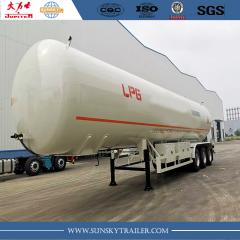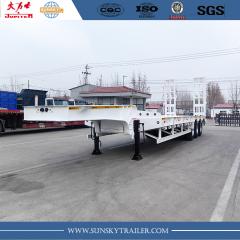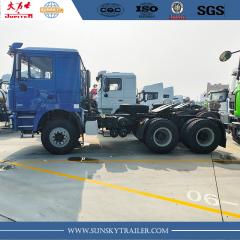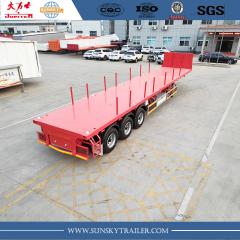-
 3 Axle Lpg Gas Tank Semi Trailer
3 Axle Lpg Gas Tank Semi Trailer
-
 Low Bed Trailer
Low Bed Trailer
-
 SHACMAN F3000 Tractor Truck
SHACMAN F3000 Tractor Truck
-
 Flatbed Pillar Trailer
Flatbed Pillar Trailer
SUNSKY VEHICLE, a manufacturer of flatbed semi-trailers, has found that the Flatbed Pillar Trailer i...
In 2022, an innovation team will continue to conduct in-depth research on the African Internet market. During the epidemic, entrepreneurs, investors and ecological support institutions in African countries have been interviewed, and a large amount of first-hand information and industry insights have been accumulated. We have selected ten ten billion-dollar tracks, focusing on the market space, regulatory environment, competitive landscape, representative companies, challenging opportunities, etc. We hope to provide a reference for entrepreneurs and investors interested in Africa and help them understand African industries. Status quo and spotting post-pandemic internet opportunities.
This report takes the African logistics track as the theme, and mainly focuses on the status quo of the African logistics industry, the opportunities and challenges it faces, the huge growth potential, especially the obvious growth of last-mile distribution services during the epidemic, and the prospect that the logistics industry can continue to Deeply cultivated areas, etc.
SUNSKY FLATBED TRAILER
1. Concept Definition
Logistics refers to the planning, implementation and management of raw materials, semi-finished products, finished products and related information from the place of origin of the commodity to the place of consumption of the commodity by means of transportation, storage, distribution, etc. at the lowest cost in order to meet the needs of customers. The whole process. Logistics generally consists of the transportation, warehousing, packaging, handling, handling, distribution processing, and related logistics information of commodities, and an optimal system formed by synthesizing and compounding each link. The management of logistics is how to transport the required materials and goods to any required place in the production and circulation fields on time, according to quality and quantity, and at the lowest cost of the system, so as to meet people's demand for goods in space and space. time requirements.
The governments of African countries pay more attention to the investment in infrastructure or the infrastructure is in good condition, the urbanization is developing rapidly, and the demand for the retail industry is growing rapidly, which is a hot area for the development of the logistics industry. In terms of the track, we divide the logistics industry in Africa into cross-border logistics, medium and long-distance transportation, last-mile transportation and geographic location service providers, and discuss the development of different players.
SUNSKY FENCE TRAILER
2. Macro environment
Benefiting from the positive factors such as the rapid urbanization in Africa, the growth of FMCG retailing, the emergence of new distribution channels (e-commerce) and a large number of infrastructure investments in recent years, the African logistics market has also shown a trend of rapid growth. According to data, the compound annual growth rate of the African logistics market is about 7.5%, which is second only to the Indian and Chinese markets in the world. According to Statista, total third-party logistics revenue in Africa was $27.6 billion in 2018, an increase of $1.4 billion from the previous year. According to a report released by Ken Research 2019, the logistics and warehousing market in Africa is expected to reach US$80 billion by 2023.
Over the past decade, globalization and technological developments have created new opportunities for the African logistics industry. In terms of policies, many African countries have stepped up efforts to build infrastructure, improve road conditions and overall transportation capacity. With the official entry into force of the African Continental Free Trade Agreement signed by 44 African countries on January 1, 2021, it is expected that by 2022, the trade ratio between countries on the African continent will increase from the current 15% to 52.3%. This is a major positive for the African logistics industry. In addition, DHL, the world's largest logistics company, has entered the African market for more than 40 years. The South African local logistics company Imperial has expanded its business to many countries in Africa, and has grown into the top 30 international logistics providers and is listed on the South African Stock Exchange.
However, there are still many challenges and difficulties in the African logistics industry. Compared with other developed regions, the outstanding problems of the African logistics industry include the backward transportation infrastructure on the African continent, the extremely unbalanced development between urban and rural areas between countries, the low level of management and technology, and the backward government supervision and corruption, which lead to logistics delivery time. Excessive length, high logistics cost, and high empty rate of trucks are prominent problems. In the 2018 global logistics performance index ranking of 167 countries released by the World Bank, South Africa ranked 29th, Botswana, Egypt, Kenya, Rwanda, Tanzania, Uganda ranked in the upper middle (ranking between 58-72), most of the other Countries ranked lower, with Nigeria, Africa's largest economy, outside the top 100.
At present, 90% of Africa's trade is by sea. In the 2018 global port throughput TOP120 list, only the Mediterranean port of Tangier in Morocco (48) and the port of Durban in South Africa (62) are on the list. The Port of Lagos, the largest port in West Africa, and the Port of Mombasa, the largest port in East Africa, have problems such as low throughput, aging infrastructure and customs corruption, which lead to long customs clearance times. The time to import auto parts through Lagos is Durban. three times.
Due to uneven road and rail links between economic centers, commercial centers are often far apart, and many road networks are in poor condition and cannot be used as trade routes, resulting in high logistics costs. According to the analysis of the World Bank, the cost of transporting goods in Africa is about 2-3 times that of developed countries, and transportation costs account for 50% to 75% of the retail price of goods. According to a 2015 estimate by the authors of "Who's Globalizing", the cost of transporting goods (per unit distance) in sub-Saharan African countries can be five times higher than in the United States. In addition, the last mile logistics costs are very high due to the lack of an accurate address system. The average international cost of the last mile is about 28% of the product cost and is estimated to reach 35% to 55% in Africa. The low loading rate of trucks further increases logistics costs. In South Africa, 40% of the space of a truck is not used, while 38% of trucks and more than 60% of trains in Africa are empty.
SUNSKY LOW BED TRAILER
One of the dilemmas facing e-commerce in Africa comes from logistics. When Alibaba established and expanded its e-commerce ecosystem in China in 2003, it took advantage of China's relatively advanced urban infrastructure, which was the result of the Chinese government's massive investment in infrastructure in the 1990s. The European and American markets have greater advantages, including a strong national postal system, and last-mile services such as FedEx and UPS that can provide overnight delivery. On the other hand, in Africa, as a whole, the amount of infrastructure investment is still insufficient relative to the demand, there is a funding gap of 68-108 billion US dollars, and there is an obvious imbalance between countries, which hinders the development of e-commerce. In 2019, Jumia launched Operations in three African markets were halted due to high shipping and fulfillment costs.
It is precisely because of the prominent pain points that many African countries are sparing no effort to invest in infrastructure construction through domestic and foreign financing. Nigeria plans to invest $20 billion in infrastructure over the next 5-10 years. With the help of China, Kenya has invested in the construction of the Mombasa-Nairobi Railway from Mombasa, the largest port in East Africa, to the capital Nairobi, and the Nairobi-Nima Railway from Nairobi to the western border city of Malaba. According to the long-term plan, the railway will also connect Kenya, Tanzania, Uganda, and Rwanda. , Burundi and South Sudan and other 6 East African countries, the total investment will be as high as 15 billion US dollars.
In the flow of venture capital in recent years, we have seen that some funds have flowed to asset-light logistics technology companies, such as Kenya's Lori System and Nigeria's Kobo360. However, development-oriented and policy-oriented financial institutions are also required to invest in asset-heavy financial institutions. More funds will be invested in the field to accelerate the overall development of the logistics industry.







